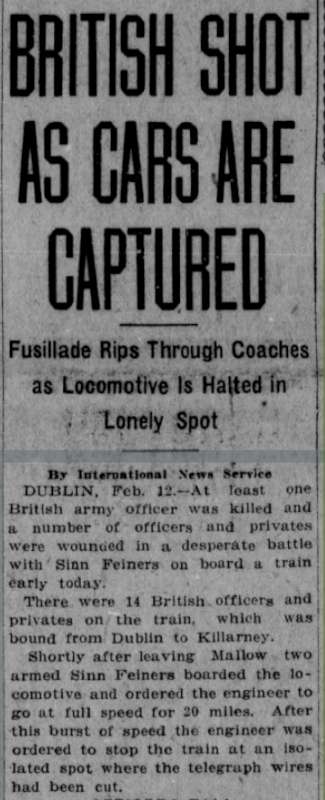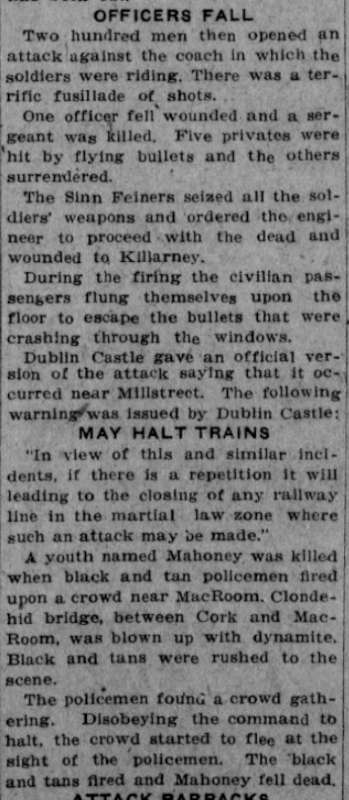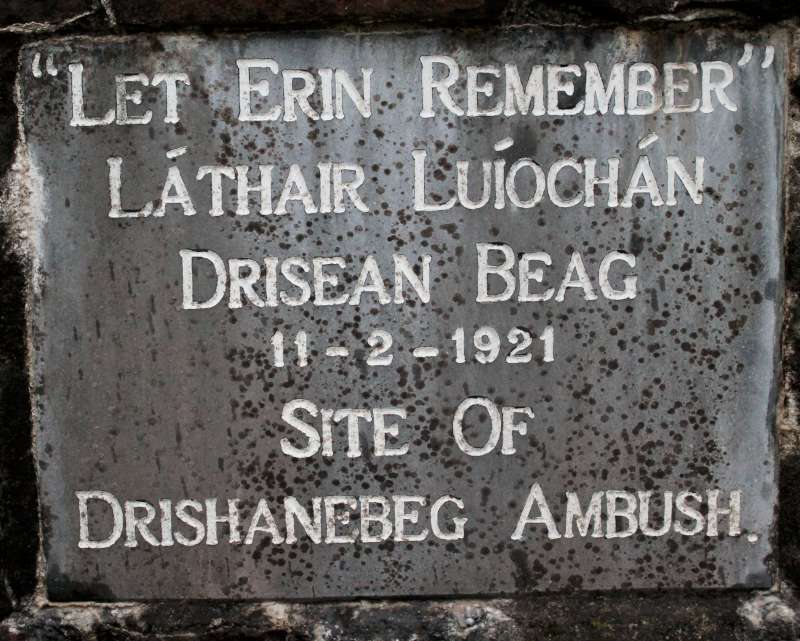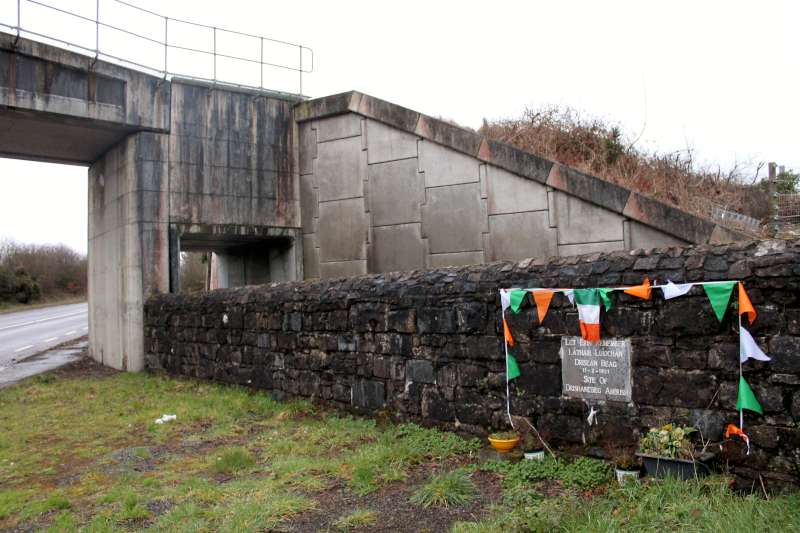In late 1920 Millstreet I.R.A. were considering the viability of an attack being made on British troops who frequently used rail transport while travelling through their battalion area. Various plans were made and men were put in position on a number of occasions during January 1921, but for various reasons a projected attack failed to materialise. Subsequently the column, under Commandant Jeremiah Crowley, re-examined the feasibility of the proposals.
The essential features for the success of any such attack were that the train containing the troops should be brought to a halt at a point where the column was already in a position, that an attack should be made only on an occasion when the troops travelling were armed, and where the party was neither too small to be worth while or too large to risk the failure of the operation. There was the further point that civilian passengers on the train had to be protected as far as possible from injuries. Trains travelling east or west were both potential targets. A position was selected at Drishanebeg about a mile west of Rathcoole station [a], between Millstreet and Banteer. On a few occasions the trains were allowed to pass unmolested, because the soldiers they carried were unarmed, but finally on the evening of 11 February, 1921 the attack came off.
About 6.30 p.m. when it was nearly dark the column went into position. The plan which had been made for bringing the train to a halt came into operation. One of the volunteers, whose duty it was to inspect the train and board it if it contained a suitable party of British forces, this evening saw that the party of troops travelling was such as could be dealt with by the column. He boarded the train and travelled to Rathcoole where two armed Volunteers were waiting. At his signal they boarded the engine as the train was leaving the station and on arrival at the ambush position forced the driver to halt the train. A long whistle blast was blown as a pre-arranged signal to the attacking party. A lighted bicycle-lamp placed on the track indicated the exact position at which the engine should stop.
The Column Commander called upon the military in the train to surrender but was answered by rifle shots. Fire was then opened upon the carriages containing the military party and the battle continued for about fifteen minutes. The slopes of the cutting were lit by oil torches prepared in advanced by the column and thrown down outside the target carriages at the beginning of the encounter. The fight was one-sided from the start, the attackers having the advantage of cover and darkness. When the British surrendered one had been killed and most of the others were wounded.
The column members collected fifteen rifles and a large quantity of ammunition and withdrew from the scene without suffering a single casualty. – Cork’s War of Independence
[a] “Drishanebeg about a mile west of Rathcoole station” This should probably read a mile east of Millstreet Station.
================
By international News Service | DUBLIN, Feb, 12.—At least one British army officer was killed and, a number of officers and pivates were wounded in a desperate battle, with Sinn Feiners on board a train early today. There were 14 British officers and privates on the train, which was bound from Dublin to Killarney. Shortly after leaving: Mallow two armed Sinn Feiners boarded the locomotive and ordered the engineer to go at full speed for 20 miles. After this burst of speed the engineer was ordered to stop the train at an isolated spot where the telegraph wires had been cut.
OFFICERS FALL – Two hundred men then opened an attack against the coach in which the soldiers were riding. There was a terrible fusillade of shots. One officer fell wounded and a sergeant was killed. Five privates were hit by flying bullets and the others: surrendered. The Sinn Feiners seized all the soldiers’ weapons and ordered tho engineer to proceed with the dead and wounded to Killarney. During the firing the civilian passengers flung themselves upon the floor to escape the bullets that were, crashing through the windows. Dublin Castle gave an official version of the attack saying that It occurred near Millstreet. The following i warning was issued by Dublin Castle;
MAY HALT TRAINS – “In view of this and similar Incidents, if there is a repetition It will leading to the closing of any railway line in the martial law zone where such an attack may he made.” A youth named Mahoney was killed when black and tan policemen fired upon a crowd near Macroom. Clondrohid Bridge, between Cork and Macroom, was blown up with dynamite. Black and tans were rushed to the scene. The policemen found a crowd gathering. Disobeying the command to halt, the crowd started to flee at the sight of the policemen. The black and tans fired and Mahoney fell dead.
ATTACK BARRACKS – The military police barracks at Drimoleague were partly destroyed by dynamite today during an attack by a large of armed men. The attackers were finally driven off. The crown forces sustained no casualties. It was reported that 300 Sinn Feiners took part in the attack and that they were led by Michael Collins, commander-in-chief of the Irish republican army – Los Angeles Herald 12th February 1921
====
TRAIN HELD UP: SOLDIERS FIRED ON BY A FORCE OF 200. A party of armed men, estimate at over 100 (the official report sms the number was nearly 200) held up the 6.30 passenger train from Mallow to Tralee last evening, about a mile outside Millstreet Station, County Cork. Some thirty soldiers occupied a portion of the train, and the attacking party opened fire on the compartments occupied by the troops, from both sides of the line. A sergeant was killed and five other ranks were wounded, some seriously. Arms and equipment were taken by the attackers. A special train conveyed the wounded this morning to the Cork Military Hospital.
[Westminster Gazette – Saturday 12 February 1921]
====
Witness Statement of Con Meany M.C.C., Rathroe House Derinagree [ref]
In January, 1921, the Officers of ‘B’ and ‘E’ Companies
planned to attack and disarm one of the small parties of British
military whom their I.Os. reported as travelling by train through
the area. As this was an operation of major importance, the
Battalion Column took charge and after lying in ambush each evening
for about a week a train containing a party of military was held
up and ambushed near Drishane on the night of February 11th, 1921.
After a short fight, the military, who had some dead and almost all
the remainder wounded, surrendered. Fourteen rifles were captured,
500 rounds of .303 rifle ammunition and 14 sets of military equipment.
To carry out this operation, a number of Volunteers armed
with revolvers waited at Millstreet Station to board any East
bound train on which a certain number of armed military might be
travelling and get the engine driver to signal and stop at the
appointed place. Other Volunteers, all armed, had positions
taken up at Rathcoole Station to deal with any west bound train.
Two of the men from Rathcoole travelled each evening to the
next station, Banteer, in order to make observations and then
return in the train to Rathcoole. It was a West-bound train
which was eventually boarded and ambushed.
The train, or to be correct its engine was boarded by two
Volunteers – Jack O’Keeffe and Dan Coakley – at Rathcoole Station
which is about 3 miles East of the selected ambush position.
These men, with drawn revolvers, informed the engine driver that
he was to carry out their instructions or his life was forfeit.
Acting on those instructions the driver blew a whistle blast
about a mile from the ambush position and the ambush party then
placed a lighted carbide cycle lamp between the rails at the point
selected to have the engine stopped. The engine overshot this
mark by about 10 yards and the ambushes on each side of the
embankments (the position was in what is known as a cutting) had
to read just their positions accordingly. Torches made from dry
sacking and kerosene oil were then lighted and thrown down the
slopes of the embankment, thus giving the attackers a clear view
of the interior of the train. An N.C.0. and 13 military were
together in one compartment. The Volunteer Battalion Commandant
called on the military to surrender but the answer was a rifle shot
from the train, which was immediately replied to by slug loaded
shot-guns and limited rifle fire from the Volunteers. The
Volunteers had only 4 regular Magazine .303 rifles and two single
shot .303 rifles. The firing lasted about seven or eight minutes
when the ambushed party shouted “We surrender”. The Commandant
then ordered “Stop firing”. Firing then ceased but after an
interval of about 30 seconds another shot was fired from the train
and the Volunteers immediately resumed their fire. In less than
a minute, in response to another shout of “We surrender” from the
train the Commandant again ordered the Volunteers to stop firing
and the military were ordered to come out of the train and leave
their arms. They then opened the door and those not seriously
wounded came out as ordered on the Southern side of the train.
A number were dying and one, at least, a Sergeant, was dead.
While the troops were emerging from their compartment, a Lieutenant,
who was apparently in hiding near the near of the train, fired a
revolver shot at the Eastern end of the ambushers position,
opened the door of his carriage and leaped out to the ground. He
was fired at but although a diligent search was made under the
train he managed to escape in the darkness.
The Volunteers then collected the arms, baggage, equipment
and ammunition, administered first aid to the wounded military,
helped them back on the train and departed to the accompanying
shouts from civilian passengers of “Up the Republic”.
There were not any Volunteer casualties.
====
The Inquest
The full details of the inquest are here: https://www.cairogang.com/soldiers-killed/millstreet-train/inquest/millstreet-inquest.html
====
Killed & wounded
Private Holyome died of wounds [anc]
Sgt F Boxold died at the scene of the ambush [Find a Grave]
Lieut C H W Clarke MBE – Clarke got his MBE for his actions at the Headford Ambush on the 21 Mar 1920
6446360 Sgt S Sutton BEM – he had got the BEM for his actions at The Grange 8.11.20
6446469 L-Sgt J Maxfield
6446562 Cpl G King
6446432 Pte A Hodge
6446263 Pte E Lloyd
In the group, unwounded, included
Cpl J Stark RASC (attached to 1 Royal Fusiliers)
L/Cpl A Buzzell
There were no Volunteer casualties.
====
Memorial Plaque
The ambush is remembered each year at the plaque commemorating the ambush, which is located at Drishanebeg Railway Bridge
====
Aftermath: Trial of Timothy Dennehy and Cornelius Cunningham
Weeks after the ambush, an informer gave their names of Timothy Dennehy (of Clash Kilbrin) and Cornelius Cunningham (of Drominagh, Clonbanin) to British forces and they were arrested and put on trial for “levying war against His Majesty the King, by joining, with certain persons unknown, in an attack with arms against a detachment of His Majesty’s forces”
My great uncle Cornelius Cunningham of Drominagh along with Timothy Dennehy of Clash, Kilbrin, were the two men that entered the train.
The trial was held on May 9th in Victoria Barrack: At the trial one of the soldiers identified Cunningham as the man who had removed numerals from the tunic of soldiers, and identified Dennehy as the man who was seizing rifles. Dennehy said that on that evening, his employer had sent him to Kanturk where he did some messages and met a friend, shared a drink, and walked their bikes home, and his witnesses backed this up. Cunningham’s witnesses went missing, assuming they were not needed, and they were brought back “to swear black was white” as one of the officers put it! Some weeks later both were acquitted. Dennehy had been interred for the duration.
The trial is detailed in the book “The Trial of Civilians by Military Courts – Ireland 1921” – by Seán Enright [Book, 2]
====
Miscellaneous
It was the only successful train ambush in the War of Independence!!!
The victory celebration after the ambush was in Twohig’s house in Kilcorney and Fr. Breen was the guest of honour. Likely that the men got confession from Fr. Breen before and after their duties that evening.
====
What Volunteers took Part?
Seán Joseph Reid [1] [2]: Mentions that he was involved in an attack on a train at Glebe, Drishane (February 1920) where a member of the British forces was killed.
Denis Dineen, the Tanyard, Millstreet: did armed guard for the Active Service Unit (ASU) and did outpost duty for same for several days before the attack on the train at Millstreet carrying military (February 1921)… [1] [2]
TODO: this could be a long list!
====
Further Reading
Cairo Gang: Millstreet Train Ambush
In Song: The Millstreet Train Ambush
The I.R.A. and Its Enemies: Violence and Community in Cork, 1916-1923
Kerry’s Fighting Story: Successful Train Ambush
====
Unfinished
Q. Were there any reprisals locally in the aftermath of the ambush?
TODO: Any other witness statements?
TODO: bring in details of the inquest
TODO: Map where exactly did the ambush happen? The only two obvious places in Drishanebeg are beside Crowleys house or within Thorntons fields [OSI Map 1890: Drishanebeg]





